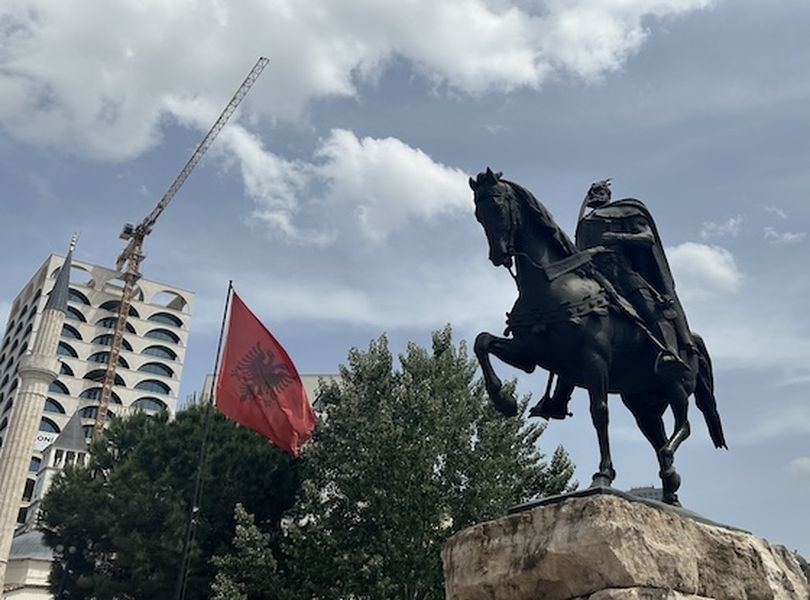Albania: One of Europe’s undiscovered treasures

As happened several years ago when I went to Kosovo, my friends wondered why I was interested in going to Albania. It’s a bit of a story.
I’ll get to Kosovo later. First, though, let’s talk about Albania and why we are so glad that we went there.
If you look at a map of the Mediterranean, Albania can be located directly east of Italy, across the Ionian Sea and just above Greece. It’s a country that few Americans are familiar with, largely because of its history.
From 1944 – when partisan forces wrested control of Albania from German control – until 1992, the country was ruled by a communist government. Strangely enough, that government – led for four-plus decades by the dictator Enver Hoxha -- was allies not with Russia but Mao Zedong’s China.
With the fall of the Soviet Union in 1989, things began to change. And by 1992, Albanians had voted for a democratic government. Since then the country has struggled at times, as most emerging nations do.
But today? Albania is on the verge of being discovered as one of the last European spots that is picturesque, accommodating to travelers and, perhaps best of all, inexpensive.
My wife, Mary Pat Treuthart, tacked on an Albanian visit to our recent trek to Florence, Italy. We’d gone to Italy to attend the 60th-anniversary festivities of the founding of the Gonzaga in Florence Program. Not only had Mary Pat taught in the undergraduate part of the program, she and her former colleague John Morey Maurice cofounded GU’s School of Law counterpart.
We departed Florence on the evening of May 19. Less than an hour later we arrived at Rome’s Fiumicino Airport, which gave us plenty of time for our 11 p.m. departure to Tirana, Albania’s capital city.
The first thing I noticed when we landed gave me an indication as to how our trip would go: The Albanians in the departure lounge were unerringly polite, far more so than the Italians I’d encountered – not to mention many Americans I’ve flown with over the years.
That was countered, for the moment, by the fact that, upon arriving in Tirana, I couldn’t figure out how to scan my passport in the machine that was set up for easy access (even though Mary Pat sailed through). I had to join a line with the other feebs and have an Albanian passport control worker hand-stamp my documents.
Then we had a hard time connecting with the driver whom Mary Pat had booked. It took several minutes to figure out where the guy was, and then when we did locate him he had trouble leaving the airport because he had misplaced his ticket.
He found it, finally (it was wadded up in his pants pocket), and we were off.
Because it was past midnight, we couldn’t see much of anything beyond the city’s lights. But the road seemed to be in decent shape, far better certainly than what I remembered of Kosovo’s capital city of Pristina. So that was another positive sign.
But the kicker came when we arrived at the Tirana Marriott Hotel. Even though it was far past midnight, the guy who checked us in was courteous and helpful. And the young woman who helped with our bags was the same, even refusing to take my offer of a 500 Lek (about $5) tip.
I slept late but still made it to the Marriott’s dining room before they stopped serving breakfast. The server I met, a guy named Rakaeld, had an interesting story concerning his name: It was a series of initials of some close relatives. He said other Albanians were always asking him where he came from.
Then we were off, heading down Dëshmorët e Kombit Boulevard (translation: Boulevard of Martyrs of the Nation), one of the city’s major thoroughfares and one that would take us to some of the city’s main sites.
One is the Pyramid of Tirana, formerly a museum and during the 1999 Kosovo War a NATO headquarters. Now it is a multi-use arts center, and once you climb to the top (or take the elevator), you get a great view of the immediate neighborhood.
The second is Skanderberg Square, the 40,000-square-meter plaza that is reminiscent or both Beijing’s Tiananmen Square Moscow’s Red Square and is the largest such public space in the Balkans. A statue of Hoxha was removed following student demonstrations in 1991, but a statue of the Albanian national hero Skanderberg (Gjergi Kastrioti) still stands.
It was a hot day, in the mid-80s, and we were eager to enter one of the city’s main museums: the National Historical Museum. But even though the guidebook we were using said it should be open, it wasn’t. (We would find out later that the place was being renovated and would be closed for the next four years.)
Disappointed, we stopped at an outdoor restaurant just off the square. Over cold drinks, we gauged our initial impressions, which were overwhelmingly positive.
One, Tirana is a lively, pretty city, its tree-lined streets lined with shops and cafes.
Two, most everyone we met spoke English.
Three, everyone we met was friendly and helpful.
Four, this place is just begging to be discovered. After enduring the crowds clogging the streets of Florence, we found ourselves able to breathe for the first time in a week.
Best of all, our trip was just beginning.
